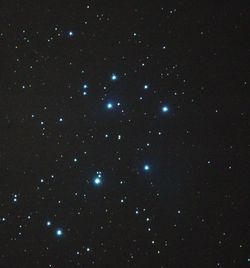Open cluster
Open star clusters are groups of stars without a defined shape and generally only have a few hundred members. These groupings are loosely held together by their mutual gravitation and have a common age and origin[1]. This makes them very useful to astronomy as this has given science much insight into stellar evolution by looking at various open clusters of differing ages. This eventually lead to the ability to determine the age of star clusters to some accuracy[2]. As open clusters are only weakly bound gravitationally, they eventually disperse as they orbit the galaxy due to interactions with other stars.
To the observer, the appearance of an open cluster can vary quite substantially. Sometimes only a few stars are visible for some clusters and sometimes there are so many stars in a cluster, they blend into a blur. Often the observing instrument has much to do with how a cluster appears. Some clusters in binoculars or very small telescopes appear as a faint fuzzy patch which, when observed through a larger telescope, resolve into individual stars, M37 for example. Other clusters just look like a group of stars in the same point in the sky regardless of the instrument used. It is notable that two quite well known open clusters, The Hyades and The Pleiades are naked eye clusters that are visible even from inside a city and that observation with binoculars or a telescope don't do much more than reveal more stars in these two clusters.
Contents |
Classifying open clusters
General terms
Since the appearance of open clusters can vary so widely from cluster to cluster, many terms have been used to describe them. In terms of the number of members, terms such as sparse or poor are used to describe clusters with few members. On the other hand rich clusters have many members. Dense clusters have most of their members close together whereas the term sparse can also be used for clusters that are widely dispersed.
Trumpler system
To avoid confusion in terminology, a system of categorizing the appearance of open clusters was developed by the Swiss-American astronomer Robert Trumpler[3] developed a system of classification for open clusters that is much more precise than the general terms used above.
The Trumpler system uses three terms to describe an open cluster. Term 1 gives an indication of the concentration of stars (how dense). Term 2 gives information on the range in brightness of the individual stars and term 3 provides information on the richness or number of stars. The table below[4] provides a definition of each term.
| Concentration of Stars | |
| I | well separated from surrounding stars, with a strong concentration to the centre |
| II | well separated from surrounding stars, with little concentration to the centre |
| III | well separated from surrounding stars, with no concentration to the centre |
| IV | Not well separated from surrounding stars with stars slowly passing into the surrounding stars and appearing like a star field condensation |
| Range in Brightness | |
| 1 | small range in brightness |
| 2 | moderate range in brightness |
| 3 | large range in brightness |
| Number of Stars | |
| p | poor clusters with less than 50 stars |
| m | moderately rich clusters with between 50 and 100 stars |
| r | rich clusters with over 100 stars |
So the Beehive Cluster is rated at I2r and the more spread out Pleiades at II3r[4].
References
- ↑ Abell, George O, Exploration of the Universe, 4th ed
- ↑ Freedman, Roger A. and Kaufmann III, William J., Universe, 8th ed.
- ↑ Weaver, Harold; Weaver, Paul, Robert Julius Trumpler, 1886-1956, Publications of the Astronomical Society of the Pacific, Vol. 69, No. 409, p.304
- ↑ 4.0 4.1 Trumpler, Robert J., Preliminary Results on the Distances, Dimensions and Space Distribution of Open Star Clusters, Lick Observatory Bulletin, Vol XIV, No. 420, pp 154-188
